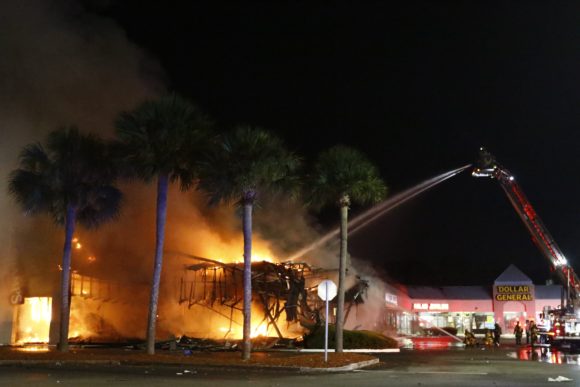Rioting that erupted in cities across the United States after the Memorial Day death of George Floyd in Minneapolis may rival the 1992 Los Angeles riots to become the most costly civil disorder in United States history.
The civil disturbance in Los Angeles after the videotaped police beating of Rodney King in April and May 1992 caused $775 million in damages — or $1.42 billion in today’s dollars, according to the Insurance Information Institute.
Those riots, however, were largely confined to one metropolitan area. Destruction and looting that erupted after Floyd’s death was reported in at least 25 cities, and spread into many suburbs as well. The extent of damage was unknown as of late Monday, but a sample of local news reports suggests that it is widespread:
- In Pittsburgh, the Public Safety department reported 50 businesses and properties in downtown area were damaged.
- The Downtown Seattle Association reported that 50 businesses had damaged downtown and in the neighboring Chinatown-International District.
- The Chicago Loop Alliance said at least 45 property were damaged in the downtown area by rioting that also spread into the cities suburbs.
- In Madison, Wisconsin, 75 businesses were damaged and some were looted.
The National Guard reported on Monday that it had deployed troops in 24 states to protect lives and property.
“We expect this to be a significant loss event as the impact is being experienced in large and small markets across the U.S.,” stated III spokesman Mark Friedlander. “However, because it is an ongoing event, it is premature to determine the volume of property loss that will be incurred.”
Civil disturbances generally cause modest property losses when compared to natural disasters, data from the Insurance Information Institute shows. Rioting in Los Angeles in August 1965 — the second costliest civil disorder — caused $357 million in damages, measured in 2020 dollars. Together, riots in Baltimore, Chicago and New York City in April 1968 caused $231 million in damages in today’s dollars.
By comparison, Hurricane Harvey in 2017 caused an estimated $20 billion in damages. Verisk’s Property Claims Service over the weekend declared the riots a catastrophe event, which means it projects damages of more than $25 million.
PCS hasn’t designated a civil disturbance as a catastrophe since the Baltimore riots in 2015.
PCS head Tom Johansmeyer said the riots that were sparked by Floyd’s death may be the first civil disorder tracked by PCS that includes more than one state.
Johansmeyer said “to better understand” potential riots from current rioting, it make sense to look at losses caused by civil unrest last year in Chile — which grew from protests over an increase in subway fares in Santiago. Rioting there caused insured losses of $2 billion. About a third of that came from property claims from a handful of large retailers.
“When you look at the United States, riot and civil disorder may generally look like a sub-US $100 million risk, although with the potential for much greater losses,” Johansmeyer said in an email to Claims Journal. “But, when you add a handful of large national or international companies with losses of more than US $100 million each, you could see a much larger industry loss begin to materialize. The large losses within the catastrophe could change the character of the overall event.”
Keefe, Bruyette & Woods analyst Meyer Shields said Monday that his best guess is losses from the current riots will be “relatively modest.” Nevertheless, the losses will combine with losses related to COVID-19 claims and property damage from a predicted above-average hurricane season to amount to a “capital event” for some reinsurers.
“As always, major losses should subsequently intensify the current hard market, but the ‘pain’ — especially for individual (re)insurers exposed to disproportionate losses — would come first,” KBW said.
The Insurance Information Institute said riots, civil commotion, vandalism, looting and fire in the U.S. are covered perils under virtually all business owners and commercial insurance property policies. Merchandise stolen by looters will also be covered.
III said about 40 percent of small to mid-sized businesses are also protected by business interruption coverage.
“Even if the business was still shut down or operating at limited capacity due to the impacts of the COVID-19 pandemic, most insurers will determine income loss based on a 12-month assessment of the operation’s income,” the Institute said in an email.
That coverage may also protect businesses that have to shut down early because of curfews imposed by city governments, III said.
About the photo: Police SWAT officers guard firefighters as they respond to the Champs Sports store after protesters looted and set the building on fire during protests on Sunday, May 31, 2020 in TampaProtests were held throughout the country over the death of Floyd, a black man who died after being restrained by Minneapolis police officers on May 25. (Luis Santana/Tampa Bay Times via AP)
Was this article valuable?
Here are more articles you may enjoy.


 Forecast Calls for Wildfires to Burn More Land Across U.S. This Year
Forecast Calls for Wildfires to Burn More Land Across U.S. This Year  GSK Zantac Appeal Gets Tough Questions From Some US Judges
GSK Zantac Appeal Gets Tough Questions From Some US Judges  Uber Spends Six Figures on Ads in Latest NY Insurance Reform Push
Uber Spends Six Figures on Ads in Latest NY Insurance Reform Push  Uber Sued by FTC Over ‘Deceptive’ Subscription Sign-Ups
Uber Sued by FTC Over ‘Deceptive’ Subscription Sign-Ups 